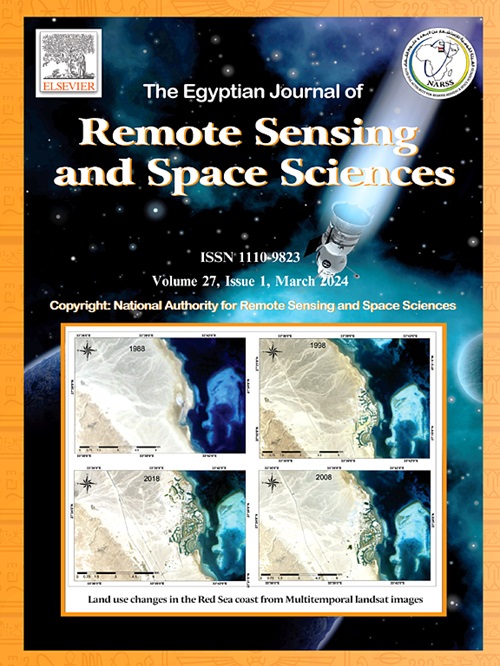一种新的加权平均集合方法在滑坡易感性制图中的应用——以元阳为例
IF 4.1
3区 地球科学
Q2 ENVIRONMENTAL SCIENCES
Egyptian Journal of Remote Sensing and Space Sciences
Pub Date : 2025-07-14
DOI:10.1016/j.ejrs.2025.07.002
引用次数: 0
摘要
滑坡敏感性制图对于风险评估至关重要,但现有的集成方法(如VotingClassifier)存在三个未解决的限制:忽略空间变异性的静态权重分配,缺乏可量化的不确定性度量,以及对可解释性工具的集成能力差。本文提出了一种新的加权平均集成方法,通过5倍空间交叉验证,动态调整随机森林(RF)、支持向量机(SVM)和极端梯度增强(XGBoost)的权重,提高了对远阳县2240 km2山地地形(23°05′-23°15′n, 102°40′-102°50′e) 817个已验证滑坡的预测鲁棒性。该方法通过结合强模型的最佳特征来解决重要问题,同时使用复合指数(如基于r = 0.81的Pearson相关性的土壤-岩石指数)减少相关变量的影响,并辅以彻底的预处理过程,包括Moran的I验证分层抽样(I = 0.12),考虑异常值的归一化(第95百分位数),以及500 m缓冲区的空间划分。新集合的准确度为84.32%,ROC AUC为91.96%,通过SHapley加性解释(SHapley Additive exPlanations)进行敏感性分析,确定降雨(21%)、距离指数(13%)和高程坡度指数(27%)是主要驱动因素,而不确定性分析显示预测区间为±0.62宽度(95%覆盖率)。生成的地图,通过空间一致性检查(AUC >;0.84),为高风险地区提供可操作的工具。本研究通过开发一个动态的、基于不确定性的系统来改进滑坡易感性制图,该系统纠正了静态集合方法的主要弱点,从而为未来的调查建立了可复制的标准。本文章由计算机程序翻译,如有差异,请以英文原文为准。
A novel weighted average ensemble method for landslide susceptibility mapping: A case study in Yuanyang, China
Landslide susceptibility mapping is critical for risk assessment, but existing ensemble methods like VotingClassifier suffer from three unresolved limitations: static weight allocation that ignores spatial variability, lack of quantifiable uncertainty measures, and poor integration of interpretability tools. This study introduces a novel weighted average ensemble method that dynamically adjusts weights for Random Forest (RF), Support Vector Machine (SVM), and Extreme Gradient Boosting (XGBoost) through 5-fold spatial cross-validation, improving prediction robustness across Yuanyang County’s 2240 km2 of mountainous terrain (23°05′–23°15′N, 102°40′–102°50′E) with 817 validated landslides. The method tackles important issues by combining the best features of strong models while reducing the effects of related variables using composite indices (like a soil-lithology index based on a Pearson correlation of r = 0.81), backed by a thorough preprocessing process that includes Moran’s I-validated stratified sampling (I = 0.12), normalization that accounts for outliers (95th percentile), and spatial division with 500 m buffers. The novel ensemble achieved an accuracy of 84.32 % and an ROC AUC of 91.96 %, with sensitivity analysis via SHAP (SHapley Additive exPlanations) identifying rainfall (21 %), distance index (13 %), and elevation slope index (27 %) as dominant drivers, while uncertainty analysis revealed prediction intervals of ±0.62 width (95 % coverage). The resulting maps, validated through spatial consistency checks (AUC > 0.84), provide actionable tools for high-risk zones. This research improves landslide susceptibility mapping by developing a dynamic, uncertainty-based system that rectifies major weaknesses in static ensemble methods, thereby establishing a replicable standard for future investigations.
求助全文
通过发布文献求助,成功后即可免费获取论文全文。
去求助
来源期刊
CiteScore
8.10
自引率
0.00%
发文量
85
审稿时长
48 weeks
期刊介绍:
The Egyptian Journal of Remote Sensing and Space Sciences (EJRS) encompasses a comprehensive range of topics within Remote Sensing, Geographic Information Systems (GIS), planetary geology, and space technology development, including theories, applications, and modeling. EJRS aims to disseminate high-quality, peer-reviewed research focusing on the advancement of remote sensing and GIS technologies and their practical applications for effective planning, sustainable development, and environmental resource conservation. The journal particularly welcomes innovative papers with broad scientific appeal.

 求助内容:
求助内容: 应助结果提醒方式:
应助结果提醒方式:


